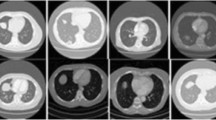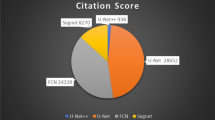Abstract
Low-dose computed tomography (CT) lung cancer screening is recommended by the US Preventive Services Task Force for high lung cancer–risk populations. In this study, we investigated an important factor affecting the CT dose—the scan length, for this CT exam. A neural network model based on the “UNET” framework was established to segment the lung region in the CT scout images. It was trained initially with 247 chest X-ray images and then with 40 CT scout images. The mean Intersection over Union (IOU) and Dice coefficient were reported to be 0.954 and 0.976, respectively. Lung scan boundaries were determined from this segmentation and compared with the boundaries marked by an expert for 150 validation images, resulting an average 4.7% difference. Seven hundred seventy CT low-dose lung screening exams were retrospectively analyzed with the validated model. The average “desired” scan length was 252 mm with a standard deviation of 28 mm. The average “over-range” was 58.5 mm or 24%. The upper boundary (superior) on average had an “over-range” of 17 mm, and the lower boundary (inferior) on average had an “over-range” of 41 mm. Further analysis of this data showed that the extent of “over-range” was independent of acquisition date, acquisition time, acquisition station, and patient age, but dependent on technologist and patient weight. We concluded that this machine learning method could effectively support quality control on the scan length for CT low-dose screening scans, enabling the eliminations of unnecessary patient dose.




Similar content being viewed by others
References
World Health Organization: Estimated cancer incidence, mortality and prevalence worldwide in 2012. 2012.
National Lung Screening Trial Research Team: Reduced lung-cancer mortality with low-dose computed tomographic screening. N Engl J Med 365(5):395–409, 2011
Moyer VA, Force USPST: Screening for lung cancer: U.S. Preventive Services Task Force recommendation statement. Ann Intern Med 160(5):330–338, 2014
National Comprehensive Cancer Network: Lung Cancer Screening. 2018.
American Cancer Society: American cancer society guidelines for the early detection of cancer.
Mettler, Jr FA et al.: Radiologic and nuclear medicine studies in the United States and worldwide: frequency, radiation dose, and comparison with other radiation sources--1950-2007. Radiology 253(2):520–531, 2009
Cai T, Giannopoulos AA, Yu S, Kelil T, Ripley B, Kumamaru KK, Rybicki FJ, Mitsouras D: Natural language processing technologies in radiology research and clinical applications. Radiographics 36(1):176–191, 2016
Litjens G, Kooi T, Bejnordi BE, Setio AAA, Ciompi F, Ghafoorian M, van der Laak J, van Ginneken B, Sánchez CI: A survey on deep learning in medical image analysis. Med Image Anal 42:60–88, 2017
Ravi D et al.: Deep learning for health informatics. IEEE J Biomed Health Inform 21(1):4–21, 2017
Ronneberger O., Fischer P., Brox T.: U-Net: Convolutional Networks for Biomedical Image Segmentation. In: Navab N., Hornegger J., Wells W., Frangi A. (eds) Medical Image Computing and Computer-Assisted Intervention – MICCAI 2015. Lecture Notes in Computer Science, vol 9351. Springer, Cham, MICCAI 2015.
Shiraishi J, Katsuragawa S, Ikezoe J, Matsumoto T, Kobayashi T, Komatsu KI, Matsui M, Fujita H, Kodera Y, Doi K: Development of a digital image database for chest radiographs with and without a lung nodule: receiver operating characteristic analysis of radiologists’ detection of pulmonary nodules. AJR Am J Roentgenol 174(1):71–74, 2000
van Ginneken B, Stegmann MB, Loog M: Segmentation of anatomical structures in chest radiographs using supervised methods: a comparative study on a public database. Med Image Anal 10(1):19–40, 2006
Jeff Shepherd S, Lin P-JP, Boone JM, Cody DD, Fisher JR, Frey GD, Glasser H, Gray JE, Haus AG, Hefner LV, Holmes RL, Kobistek RJ, Ranallo FN, Rauch PL, Rossi RP, Seibert JA, Strauss KJ, Suleiman OH, Schenck JR, Thompson SK: Quality control in diagnostic radiology. American Association of Physicists in Medicine, 2002
American Association of Physicists in Medicine: Lung Cancer Screening CT Protocols, 2016.
National Research Council: Health risks from exposure to low levels of ionizing radiation: BEIR VII phase 2. Washington, DC: The National Academies Press, 2006, p. 422
Acknowledgments
This work is supported by the Radiology Pilot Grant from Department of Radiology, School of Medicine in University of Colorado. We would like to thank the PACS and clinical analysis team from University of Colorado Health for providing technology support.
Author information
Authors and Affiliations
Corresponding author
Additional information
Publisher’s Note
Springer Nature remains neutral with regard to jurisdictional claims in published maps and institutional affiliations.
Rights and permissions
About this article
Cite this article
Huo, D., Kiehn, M. & Scherzinger, A. Investigation of Low-Dose CT Lung Cancer Screening Scan “Over-Range” Issue Using Machine Learning Methods. J Digit Imaging 32, 931–938 (2019). https://doi.org/10.1007/s10278-019-00233-z
Published:
Issue Date:
DOI: https://doi.org/10.1007/s10278-019-00233-z




